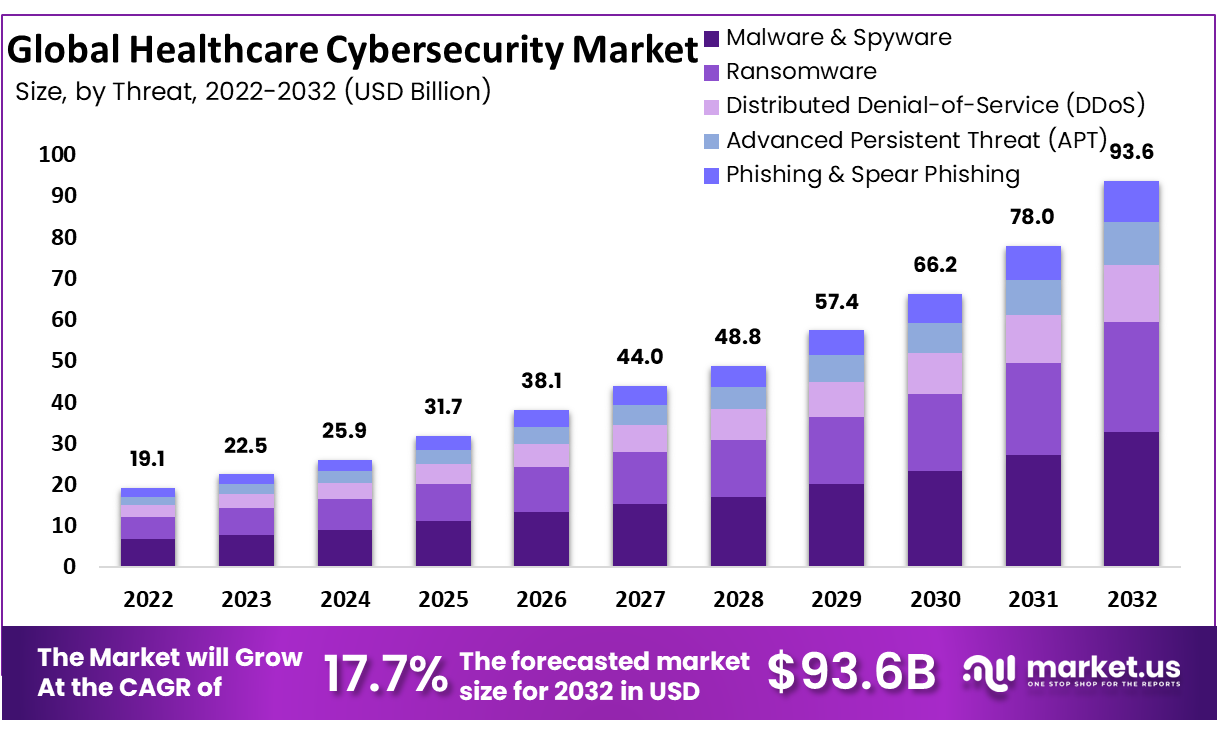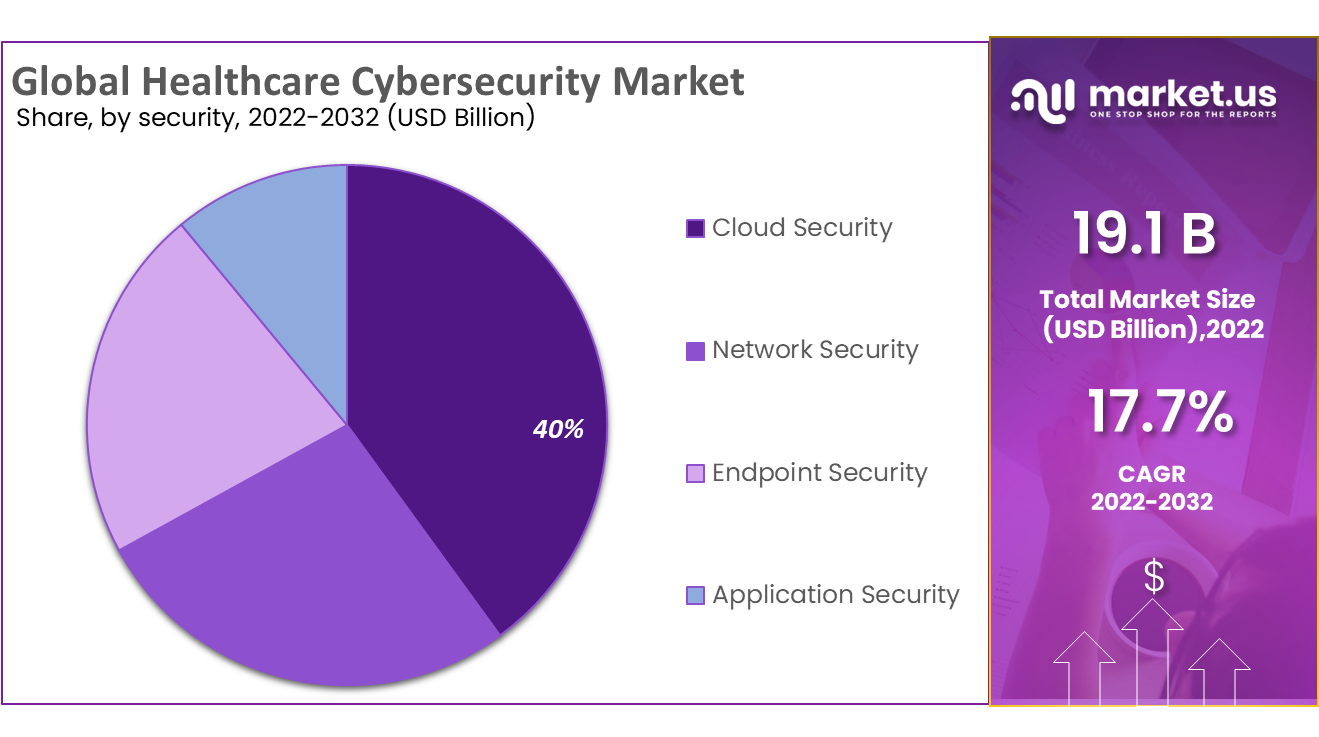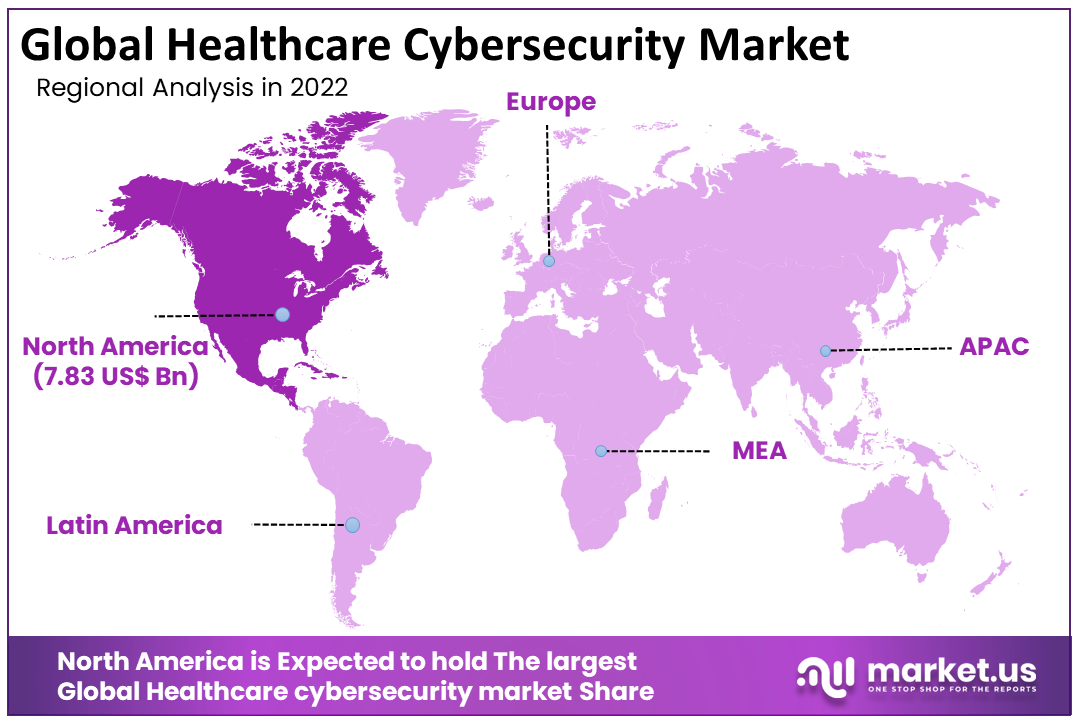Global Healthcare Cybersecurity Market, By Threat (Ransomware, Malware & Spyware, Distributed Denial-of-Service (DDoS), Advanced Persistent Threat (APT) and Phishing & Spear Phishing), By Deployment Mode (On-Premises, and Cloud-Based), By Component (Solutions, and Services), By Region and Companies - Industry Segment Outlook, Market Assessment, Competition Scenario, Trends, and Forecast 2023-2032
- Published date: Dec 2023
- Report ID: 102715
- Number of Pages: 251
- Format:
- keyboard_arrow_up
Quick Navigation
Report Overview
In 2022, the Global Healthcare Cybersecurity Market was valued at USD 19.1 Billion. Between 2023 and 2032, this market is estimated to register a CAGR of 17.7%.
The healthcare cybersecurity market refers to the sector that provides cybersecurity solutions to protect the sensitive information and data of the healthcare industry from cyber threats. This market is growing rapidly due to the increasing number of cyber-attacks on healthcare organizations and the growing adoption of digital healthcare technologies.
The report cites factors such as the increasing frequency of healthcare data breaches, the rising adoption of healthcare IT solutions, and the growing demand for cloud-based security solutions as key drivers of the market’s growth. The healthcare cybersecurity market includes various solutions such as network security, endpoint security, application security, and cloud security.
These solutions are offered by a range of vendors, including established cybersecurity companies, healthcare IT providers, and specialized healthcare cybersecurity firms. Overall, the healthcare cybersecurity market is expected to continue its strong growth trajectory as healthcare organizations increasingly prioritize cybersecurity in their IT investments and as the threat landscape continues to evolve.

Key Takeaways
- Market Size and Growth: In 2022, the global healthcare cybersecurity market was valued at USD 19.1 Bn, with an estimated CAGR of 17.7% from 2023 to 2032.
- Dominant Threat: Malware and spyware, especially ransomware, hold a prominent position, affecting at least 92 healthcare institutions in the US.
- Deployment Mode: Cloud-based deployment leads with a current share due to scalability benefits, accounting for over 41% of the market’s revenue in North America.
- Key Component: The solutions sector, including IDS/IPS and antivirus, holds the greatest market share, driven by rising demand for advanced security operations.
- Fastest-Growing Security Segment: Cloud security exhibits the fastest CAGR, propelled by increased Internet of Things device usage in healthcare.
- Major End-User: Healthcare payers claim the largest market share in revenue, driven by rising awareness of electronic health records and government efforts to secure patient information.
- Driver for Market Growth: The rise in cybercrime and healthcare spending fuels a growing demand for cybersecurity solutions, expecting market value to reach USD 93.6 Bn by 2032.
- Market Restraint: Lack of awareness among healthcare workers hampers growth, emphasizing the need for an increased understanding of cybersecurity’s significance in the industry.
- Opportunity from Phishing Incidents: The market benefits from a surge in phishing incidents in the healthcare industry, driven by increased internet and digital platform usage.
- Geographical Dominance: North America dominates the market with a revenue share of over 41%, attributed to major companies and increased cybersecurity adoption in healthcare.
Threat Analysis
The malware & Spyware segment dominated the market. There are numerous difficulties with cyber security in the healthcare sector. It consists of malware that patient privacy and system integrity as well as Distributed Denial of Service (DDoS) assaults that impair healthcare professionals’ capacity to deliver high-quality patient care.
Because of hackers’ awareness of and affinity for ransomware, ransomware attacks are the most common form of malware. At least 92 healthcare institutions in the US experienced ransomware attacks. As a result, criminals sought a minimum of 169,446 USD in ransoms from the country’s healthcare sector, earning them about USD 15.6 million.
Deployment Mode Analysis
The deployment mode that is currently dominating the healthcare cybersecurity market is cloud-based deployment. Cloud-based deployment involves hosting the cybersecurity solution on a third-party cloud platform, such as Amazon Web Services (AWS) or Microsoft Azure. This option allows healthcare organizations to scale their security solutions more easily and often comes with lower upfront costs, but may raise concerns about data privacy and security.
In the premises deployment mode, the cybersecurity solution is installed and run on the healthcare organization’s servers or hardware. This gives the organization complete control over the security of its data and systems but also requires a significant investment in hardware and maintenance.
Component Analysis
Based on Component, it is predicted that the solutions sector would hold the greatest market share for healthcare cybersecurity. The significant market share of this sector is primarily attributable to factors like the rising demand for advanced security operations solutions, the rise in data security and privacy concerns, and the rising need for reliable and affordable security solutions to boost cybersecurity infrastructure.
Also, the market for healthcare cybersecurity is anticipated to rise due to factors like the increasing sophistication of cyberattacks, increased awareness of electronic health records (EHRs), and rising regulatory enforcement and protection concerns.
Security Analysis
Based on security, the cloud security segment is growing at the fastest CAGR. The expansion of this market is primarily driven by the increase in Internet of Things device usage and the volume of sensitive data in the healthcare industry.
Additionally, it is anticipated that the growing usage of cloud storage services and the adoption of cloud-based security technologies and services will support the expansion of the cloud security market.
End-User Analysis
The healthcare payers segment accounted for the greatest market share in terms of revenue among end users. The development of this market is anticipated to be supported by rising awareness of electronic health records, an increase in data security concerns, a variety of government assistance efforts, and rules and regulations for e-health solutions. Governments are taking action to protect patient information from cyber threats.

Key Market Segments
Based on Threat
- Ransomware
- Malware & Spyware
- Distributed Denial-of-Service (DDoS)
- Advanced Persistent Threat (APT)
- Phishing & Spear Phishing
Based on Deployment Mode
- On-Premises
- Cloud-Based
Based on Component
- Solutions
- Identity and Access Management
- Intrusion Detection System (IDS)/ Intrusion Prevention System (IPS)
- Antivirus and Antimalware
- Risk and Compliance Management
- Distributed Denial of Service (DDoS) Mitigation
- Security Information and Event Management (SIEM)
- Firewall
- Unified Threat Management
- Services
- Managed Security Services
- Deployment & Integration
- Support & Maintenance
Based on Security
- Network Security
- Endpoint Security
- Cloud Security
- Application Security
Based on End-User
- Hospital
- Pharmaceutical and Biotechnology Industries
- Healthcare payers
- Other End-Users
Drivers
Growing demand for cyber security in the healthcare industry
Cyberattacks and data breaches in the healthcare industry have changed the market for cyber security. Due to basic factors such as rising cybercrime, rising healthcare spending, and the growing importance of cybersecurity in the healthcare industry, it is predicted that the market for healthcare cybersecurity would grow over the course of the forecast period.
The various international government measures to protect personal information will greatly accelerate the market growth for healthcare cyber security. Healthcare organizations, such as hospitals, clinics, and pharmaceutical companies, must prioritize safety. The rise in internet and device usage in the industry is a key element driving the healthcare cybersecurity market. Remote access devices were used more frequently as a result of the COVID-19 pandemic.
Restraints
Lack of awareness
The healthcare cybersecurity market is expected to grow over the course of the forecast period, but some limitations will certainly slow growth. Healthcare workers and others lack awareness of the significance of cyber security, especially in relation to security software.
For healthcare companies, medical records continue to be both a risk and a useful resource. The black market makes use of several pieces of personal information, such as social security numbers and bank account details. It is essential to keep up with these risks and adapt to technological developments.
Opportunity
Rising phishing incidents in the healthcare industry
The pandemic has led to an increase in phishing incidents in the industry, and the market has grown. As more industries, including the healthcare industry, use the internet and numerous digital platforms, the demand for cybersecurity is increasing. The availability of cutting-edge cybersecurity solutions is also projected to support the market’s growth.
Healthcare cybersecurity systems are the subject of increasing investments and activities from governments and a variety of healthcare organizations. Healthcare cybersecurity is a growing sector as a result of the increase in data breaches.
Trends
The healthcare industry has become increasingly reliant on technology in recent years, with the adoption of electronic health records, connected medical devices, and telehealth services. While these advancements have brought significant benefits to patients and healthcare providers, they have also created new cybersecurity risks and challenges.
Here are some of the key trends in the healthcare cybersecurity market
Increasing frequency and sophistication of cyber-attacks
Cyber-attacks on healthcare organizations have been on the rise in recent years, with hackers targeting sensitive patient data and disrupting critical healthcare services. These attacks are becoming more sophisticated, with attackers using advanced techniques like ransomware to extort money from healthcare providers.
Growing demand for cybersecurity solutions
As healthcare organizations become more aware of the cybersecurity risks, they face, there is a growing demand for cybersecurity solutions that can help protect patient data and critical infrastructure. This has led to the emergence of a wide range of cybersecurity products and services tailored specifically to the healthcare industry.
Regulatory compliance requirements
Healthcare organizations are subject to strict regulations and standards around data privacy and security, such as HIPAA and GDPR. Failure to comply with these regulations can result in significant fines and reputational damage. As a result, healthcare organizations are investing in cybersecurity solutions to help them meet these compliance requirements.
Focus on securing medical devices
The increasing use of connected medical devices, such as insulin pumps and pacemakers, has created new cybersecurity risks. Hackers can exploit vulnerabilities in these devices to gain access to sensitive patient data or even control the devices themselves. As a result, healthcare providers are increasingly focused on securing these devices and ensuring they are not vulnerable to cyber-attacks.
Regional Analysis
With a revenue share of over 41%, North America dominated the market for healthcare cyber security. The existence of major companies and the rising use of cyber security by healthcare organizations are the main contributing factors to market growth. The industry is being driven by the rising investment in technology advancement and cyber security. The development of the healthcare industry’s infrastructure is another factor.
Also, the introduction of ground-breaking products to protect patient data in the healthcare sector is fueling market expansion. For instance, Cisco unveiled the most recent iteration of the “Cisco Umbrella” in 2018. It was implemented at the University of Kansas Hospital to defend against ransomware and safeguard medical equipment and financial data.

Key Regions
- North America
- The US
- Canada
- Mexico
- Western Europe
- Germany
- France
- The UK
- Spain
- Italy
- Portugal
- Ireland
- Austria
- Switzerland
- Benelux
- Nordic
- Rest of Western Europe
- Eastern Europe
- Russia
- Poland
- The Czech Republic
- Greece
- Rest of Eastern Europe
- APAC
- China
- Japan
- South Korea
- India
- Australia & New Zealand
- Indonesia
- Malaysia
- Philippines
- Singapore
- Thailand
- Vietnam
- Rest of APAC
- Latin America
- Brazil
- Colombia
- Chile
- Argentina
- Costa Rica
- Rest of Latin America
- Middle East & Africa
- Algeria
- Egypt
- Israel
- Kuwait
- Nigeria
- Saudi Arabia
- South Africa
- Turkey
- United Arab Emirates
- Rest of MEA
Key Players Analysis
The market for healthcare cyber security is expected to increase as a result of major market players’ ongoing investments in the creation of goods with cutting-edge technologies to acquire a competitive advantage over rivals. As an illustration, IBM stated in November 2021 that it will expand its cyber security and response capabilities by purchasing Reaqta, a Dutch cyber security threat detection and response company.
Market Key Players
- IBM
- Symantec
- Macafee
- Kaspersky
- Northrop Grumman
- Fortinet Inc
- Cisco
- Trend Micro
- Imperva Inc
- Lockheed Martin
- Medigate Ltd
- Fire eye
- Intel
- LLC
- Atos SE
- Palo Alto Networks, Inc.
- Booz Allen Hamilton, Inc.
- Other Key Players
Recent Developments
- ReaQta, a Netherlands cyber security threat detection and response startup, was purchased by IBM in November 2021 as part of an announcement to expand its cyber security and response capabilities.
- In May 2022, Clearwater acquired CynergisTek, a company that offers cybersecurity, compliance, and IT services to assist highly regulated businesses in addressing security and privacy challenges. Through this agreement, CynergisTek is better able to serve the healthcare sector and its clients while also advancing its people-centric approach to cybersecurity, privacy, and audit.
Report Scope
Report Features Description Market Value (2022) USD 19.1 Bn Forecast Revenue (2032) USD 93.6 Bn CAGR (2023-2032) 17.7% Base Year for Estimation 2022 Historic Period 2016-2022 Forecast Period 2023-2032 Report Coverage Revenue Forecast, Market Dynamics, COVID-19 Impact, Competitive Landscape, Recent Developments Segments Covered Threat, Deployment Mode, Component, Security, End-User Regional Analysis North America – The US, Canada, & Mexico; Western Europe – Germany, France, The UK, Spain, Italy, Portugal, Ireland, Austria, Switzerland, Benelux, Nordic, & Rest of Western Europe; Eastern Europe – Russia, Poland, The Czech Republic, Greece, & Rest of Eastern Europe; APAC – China, Japan, South Korea, India, Australia & New Zealand, Indonesia, Malaysia, Philippines, Singapore, Thailand, Vietnam, & Rest of APAC; Latin America – Brazil, Colombia, Chile, Argentina, Costa Rica, & Rest of Latin America; Middle East & Africa – Algeria, Egypt, Israel, Kuwait, Nigeria, Saudi Arabia, South Africa, Turkey, United Arab Emirates, & Rest of MEA Competitive Landscape IBM, Symantec, Macafee, Kaspersky, Northrop Grumman, Fortinet Inc, Cisco, Trend Micro, Imperva Inc, Lockheed Martin, Medigate Ltd, Fire eye, Intel, LLC, Atos SE, Palo Alto Networks, Inc., Booz Allen Hamilton, Inc., Other Key Players Customization Scope Customization for segments, region/country-level will be provided. Moreover, additional customization can be done based on the requirements. Purchase Options We have three licenses to opt for: Single User License, Multi-User License (Up to 5 Users), Corporate Use License (Unlimited User and Printable PDF) Frequently Asked Questions (FAQ)
What is the healthcare cybersecurity market?The healthcare cybersecurity market refers to the industry that provides security solutions and services to protect healthcare organizations' digital systems, networks, and patient data from cyber threats and breaches.
Why is healthcare cybersecurity important?Healthcare cybersecurity is crucial because the healthcare sector deals with sensitive patient information, including medical records and personal data. Protecting this data is essential to maintain patient privacy, prevent identity theft, ensure the integrity of medical records, and safeguard against ransomware attacks.
What are the primary drivers of the healthcare cybersecurity market?The main drivers of the healthcare cybersecurity market include the increasing frequency and sophistication of cyber attacks targeting healthcare organizations, growing regulatory requirements for data protection, rising awareness about cybersecurity risks, and the expanding use of digital healthcare technologies.
What are some common cyber threats faced by the healthcare sector?Common cyber threats faced by the healthcare sector include ransomware attacks, data breaches, phishing attempts, malware infections, insider threats, and denial-of-service (DoS) attacks.
What types of solutions and services are offered in the healthcare cybersecurity market?The healthcare cybersecurity market offers a range of solutions and services, including network security, endpoint protection, data encryption, threat intelligence, vulnerability assessment, incident response, access management, identity and access control, training and education, and security consulting.
 Healthcare Cybersecurity MarketPublished date: Dec 2023add_shopping_cartBuy Now get_appDownload Sample
Healthcare Cybersecurity MarketPublished date: Dec 2023add_shopping_cartBuy Now get_appDownload Sample - International Business Machines Corporation Company Profile
- NortonLifeLock, Inc. Company Profile
- Macafee
- Kaspersky
- Northrop Grumman Corporation Company Profile
- Fortinet Inc
- Cisco
- Trend Micro
- Imperva Inc
- Lockheed Martin
- Medigate Ltd
- Fire eye
- Intel
- Abu Dhabi National Paper Mill LLC Company Profile
- Atos SE
- Palo Alto Networks, Inc.
- Booz Allen Hamilton, Inc.
- Other Key Players
- settingsSettings
Our Clients
| Single User $4,599 $3,499 USD / per unit save 24% | Multi User $5,999 $4,299 USD / per unit save 28% | Corporate User $7,299 $4,999 USD / per unit save 32% | |
|---|---|---|---|
| e-Access | |||
| Report Library Access | |||
| Data Set (Excel) | |||
| Company Profile Library Access | |||
| Interactive Dashboard | |||
| Free Custumization | No | up to 10 hrs work | up to 30 hrs work |
| Accessibility | 1 User | 2-5 User | Unlimited |
| Analyst Support | up to 20 hrs | up to 40 hrs | up to 50 hrs |
| Benefit | Up to 20% off on next purchase | Up to 25% off on next purchase | Up to 30% off on next purchase |
| Buy Now ($ 3,499) | Buy Now ($ 4,299) | Buy Now ($ 4,999) |












